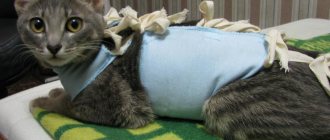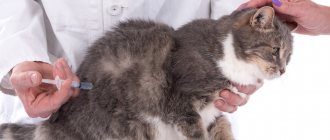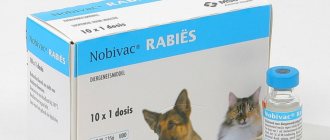Veterinarians advise not to postpone sterilization of a cat indefinitely, since with each passing year the likelihood of postoperative risks increases. The intervention is recommended for all animals not involved in breeding, and is recognized as the most effective prevention of oncology.
Why do you need to sterilize your cat?
After puberty, cats begin to look for a mate. They leave scent marks, scream at night and constantly try to escape from the house. This is a difficult period for every owner. Despite the difficulties that arise, not everyone is in a hurry to resort to surgical intervention, fearing possible risks. Most often, owners resort to an alternative solution - hormonal drugs. They really suppress sexual desire, but with constant use they carry much more risks: the growth of tumors, the development of pathologies of the reproductive system (cyst, pyometra) and urinary systems.
Unlike hormonal drugs, sterilization permanently eliminates sexual desire and reproductive function. It has a beneficial effect on the pet’s condition, protects it from cancer and prolongs its life.
Types and methods of surgical intervention
There are several types of surgical intervention in the reproductive system of cats. They differ in the method of implementation and purpose:
- Ovariohysterectomy. The essence of the operation is that both the uterus and ovaries of the cat are removed through an incision in the abdomen. The result is the complete elimination of sexual desire and the ability to reproduce. This is the optimal way to castrate cats and older animals that have already given birth.
- Ovariectomy. The operation involves removing the ovaries while preserving the uterus. During surgery, two small incisions are made through which the ovaries are removed with a special instrument and then amputated. Like an ovariohysterectomy, the procedure stops sexual activity and the ability to reproduce. It is applied to cats that have not yet gone into heat.
- Chemical sterilization. It involves introducing drugs into the cat’s body that reduce the production of sex hormones. It gives a temporary effect and is prescribed only in cases where surgical intervention is impossible (for example, if the cat is sick). Long-term use of such drugs leads to a number of serious diseases, including oncology.
- Tubal occlusion. The essence of the operation is that the fallopian tubes are ligated, but other organs of the reproductive system remain intact. Its result is the preservation of the cat’s sexual behavior, but the inability to have offspring. This is classic sterilization.
Access to the reproductive organs of an animal for the purpose of sterilization is carried out in three ways:
- An incision is made along the linea alba. The most common method. Suitable for ovariohysterectomy. The cat's fur is shaved from the navel to the last pair of nipples, and an incision is made through which the uterus and ovaries are removed. The incision is relatively large, but passes through the connective tissue without injuring the muscles.
- Side cut. Used in oophorectomy. It is small in size, so it is used in the sterilization program for homeless animals. Veterinarians do not like this method due to the inability to visually assess the condition of internal organs. With small incisions, it is quite traumatic, since it is performed directly through muscle tissue.
- Laparoscopy. It is performed by introducing a laparoscope and a special manipulator into the abdominal cavity through small punctures (less than 1 cm in length). Does not require sutures, combines the possibility of full visual control and ultra-low tissue trauma. It is the most expensive, as it requires special equipment and a doctor with appropriate qualifications.
Surgical intervention for sterilizing a cat is performed along the linea alba (1), lateral incision (2) or by laparoscopy (3)
Difference between castration and sterilization
Sterilization (oophorectomy) is tubal ligation with or without removal of the ovaries. Most often, veterinarians perform castration (ovariohysterectomy), which involves removing not only the ovaries, but also the uterus. This method is more effective, as it eliminates the development of tumors and inflammatory diseases in the uterus.
Many people confuse these concepts, separating them not by the specifics of the procedure, but by gender. In everyday life, it is believed that females are sterilized and males are castrated. For convenience, instead of “castration” we will use the more familiar term “sterilization”.
conclusions
Whether to sterilize a cat or not is everyone's choice. If you want to protect your pet or save your nerves, then schedule a procedure. If, for ethical reasons, you consider this procedure barbaric, simply ignore the calls and do as you wish.
The price for sterilizing a cat ranges from 1,500-5,000 rubles in the regions and from 3,000 rubles in large cities.
INTERESTING: Volunteers and volunteers encourage hospitals and veterinarians to participate in the “Preferential sterilization” campaign. The essence of the campaign is to carry out the procedure of sterilization of homeless and stray cats for free. Thus, trying to reduce the number of homeless cats, the number of which, according to some estimates, tends to reach half a billion individuals.
Brief description of the operation
To minimize possible complications, preparatory measures are recommended. They include not only actions immediately before surgery, but also ongoing disease prevention. In particular, this refers to annual vaccination.
Preparing the animal
Anesthesia weakens the immune system, increasing the risk of infection by harmful microorganisms and parasites. For safety, it is recommended to vaccinate your pet at least a month before the procedure. Treatment for helminths is carried out within 1.5-2 weeks. In the absence of timely vaccination, the cat is given a serum injection that stimulates a stable immune response for 2 weeks.
A few days before surgery, a urine and blood test is taken from the tailed patient. To determine the safe dosage of a narcotic substance, the functioning of the heart and respiratory organs is checked using ultrasound and x-rays.
It is recommended to give up feeding 12 hours before, and water 3 hours before. This eliminates the occurrence of vomiting, which provokes the development of aspiration pneumonia.
Choosing a clinic and veterinarian
Pets that don't go outside are afraid to leave their familiar territory. To minimize stress, it is better to choose a clinic closer to home. Walking distance will eliminate travel by transport, reducing the time you spend outside your usual conditions.
For especially timid pets, calling a veterinarian to your home is a good idea. This eliminates the stress caused by a change of environment and the risk of infection from other visitors. The disadvantage of home surgery is the low sterility and lack of equipment necessary to eliminate possible complications. Most clinics provide both types of services, so the choice is up to the owner.
It is ideal if you vaccinate your animal and take it for routine examinations to the same clinic and to the same doctor. A regular veterinarian is familiar with the characteristics of the body.
Progress of the procedure
After anesthesia is administered to the tailed patient, the hair is removed at the site of the future incision or puncture. The procedure itself is carried out in two ways:
- surgical, involving classical excision with a scalpel;
- laparoscopic, based on the creation of small punctures using endoscopic equipment.
In both cases, after making an incision, the surgeon removes the reproductive organs and applies stitches. They are removable and non-removable. The first ones are removed 7-10 days after the procedure, and the second ones resolve on their own.
How to prepare an animal for surgery
Since neutering is a non-hazardous operation, there are no special measures or procedures to prepare the cat. The main thing is that the animal does not eat anything for 12 hours before sterilization. That is, if the operation is scheduled for 12 days, then the pet can be fed for the last time no later than 12 at night.
If there are several animals in the house, it is recommended that the cat being prepared for surgery be placed in a room where there is no access to the feeding troughs of other animals. When this is not possible, then all pets will have to starve a little.
A few hours before the operation, it is better to remove the water, because if it is in the stomach during the administration of anesthesia, the cat may vomit. This is because narcotic drugs contain substances that cause nausea. And if a cat aspiration of vomit occurs, a complication may occur, expressed in aspiration pneumonia. Therefore, the issue of animal starvation must be treated very responsibly.
Pros and cons of sterilization at different ages
When sterilizing, age plays a primary role. Veterinarians' opinions on the ideal age vary, but the fact that a young body is at lower risk remains the same.
Early (before first heat)
Foreign veterinarians believe that it is better to sterilize a cat when it has not yet reached puberty. This approach guarantees rapid tissue regeneration, reducing postoperative risks. Surgery is performed at 3-6 months.
Opponents of this approach cite possible developmental delays, changes in behavioral characteristics, and the development of pathologies of the eyes, kidneys and endocrine system. There is no consensus here, since supporters of early sterilization have a completely opposite opinion. They are confident that the operated animal grows up healthier.
During puberty
Most veterinarians recommend operating on your pet closer to her first heat, that is, at 7-8 months. Exceptions include kittens of different sexes from the same litter growing up together. They reach puberty earlier, so the date of surgery can be delayed by 4-6 months. Before making a decision, the veterinarian weighs the tailed patient. Its weight should be at least 2.5-3 kg. Otherwise, the operation will be delayed.
In old age
People who have picked up adult animals on the street are constantly wondering at what age a cat can be sterilized. In their case, the chance for early intervention has already been missed, so the issue is resolved individually.
Veterinarians believe that surgery is possible up to 10 years of age. After this age, the pet is considered old, and the likelihood of complications increases to a critical level. Surgery is performed only for special indications that threaten the life of the tailed patient.
Features of sexual development in different breeds
The timing of puberty varies from breed to breed. If your pet begins to show signs of heat too early, check with your veterinarian at what age cats of this breed are sterilized. Representatives of the Siamese-Oriental group mature from 4 months, and large long-haired breeds (Maine Coons, Persians, Siberians) - up to 1 year.
How to care for a cat after sterilization
Few owners have a complete idea of what to do after sterilizing a cat. Meanwhile, it is the postoperative period that determines the further state of the pet’s health.
If it is not possible to leave the cat in the clinic for the first few days, and she is “discharged” home immediately after the operation, you need to learn in detail all the nuances of care from a veterinarian. Depending on the pet’s condition before and after the intervention, she may be prescribed antibacterial drugs, anti-inflammatory drugs or painkillers. In addition, the specialist will tell you when (and whether) you need to come to remove the stitches, how often to do dressings, what products are best to use in this case, and other information. It would be good if the veterinarian can give his phone number so that in case of a sharp deterioration in the condition, he can be contacted without delay.
Features of transporting an animal from the clinic
You need to take your cat home not in your arms, but by placing it in a special carrier that has a flat and even bottom. Any shaking or displacement of the torso can cause the seams to separate. It is advisable to cover the animal with a light blanket or warm cloth, since due to the operation and anesthesia, the pet’s body temperature becomes lower than normal.
Where is the best place to place a cat in an apartment?
While the cat is recovering from sterilization, it is best for her to be on the floor. The owner needs to arrange the bed in advance: choose a spacious place where no one can disturb the animal, lay down a blanket, and put waterproof diapers on top. To ensure free flow of saliva, the pet should be placed on its right side.
It is imperative to ensure that the place reserved for the cat is not in a draft or near a heating device. However, you will still need to cover it; to do this, just take a light but dense fabric.
What to wear on a cat after sterilization
Cat in a blanket after sterilization
After sterilization, the cat's stomach should be isolated from the external environment to avoid infection of the wound. To do this, use a blanket - special clothing with slots for paws, fastened with Velcro or tape on the back of the animal. The device should be worn for about 10-14 days, depending on the complexity of the operation, the condition of the seam and other nuances.
Cat blankets should be washed, ironed, and then put on again. Such clothing is removed only to treat the surgical wound. To prevent your pet from taking it off, there should be no threads or loose ends of ties sticking out on the blanket. The product is selected only according to individual sizes, since the animal will easily remove a wide blanket, while a narrow blanket will interfere with blood flow.
Some owners sew such bandages themselves. Sometimes tights or socks are used as a means of improvisation, having previously cut holes. Whether the cat will wear such a blanket is unknown. Judging by the stories of owners on the Internet, many animals stage concerts or behave aggressively, even without fully recovering from anesthesia. As a result, the blanket is replaced with a collar, and the bandage on the wound is fixed with a plaster.
Coming out of anesthesia
The cat's behavior after surgery becomes inadequate and unpredictable due to anesthesia. During the first 1-2 days, the animal should not be left alone for a long time. Coming out of a narcotic state is accompanied by complete disorientation in space, staggering, wobbly limbs, screaming, meowing, aggression and other manifestations.
The duration of recovery of a cat from anesthesia can range from 5-6 hours to a day or more. But the pet usually begins to come to its senses 2-4 hours after the operation. There is no need to give her anything to drink, much less eat, at this time. It is allowed to moisten the oral cavity with water from a spoon or syringe.
How to feed a cat after sterilization
It is prohibited to feed the cat within 24 hours after sterilization. This is associated with the risk of a gag reflex (due to anesthesia) and decreased intestinal activity. Any contraction of the abdominal muscles or intestinal wall can lead to the opening of the wound or provoke intra-abdominal bleeding. Liquid food in the form of broth, meat ground and mixed with broth, porridge with water can be introduced into the animal’s diet approximately on the second day. You will need to follow a liquid diet until the stitch is removed.
If your cat refuses food and water
The first day after sterilization, the pet may not have an appetite. The alarm should be sounded if the cat does not eat or drink for more than 2 days, and all attempts to give it liquid food or water using a syringe end in failure. To recover, she definitely needs to take at least broth. To prevent dehydration and exhaustion of the pet, the owner should contact the clinic - an alternative may be intravenous nutrition.
Toilet problems
It happens that a cat does not go to the toilet after sterilization. If this happens within 1-2 days after surgery, then there is no need to worry. Due to preoperative fasting and dehydration, she simply has nothing to empty her bowels with. Other reasons for this phenomenon include:
- stress from surgery;
- the effect of anesthesia or drugs;
- the blanket gets in the way;
- the seam hurts.
Lack of bowel movements with normal appetite may indicate constipation. In this case, laxatives and a liquid diet will help. If your cat continues to have problems with the toilet more than 3 days after sterilization, you should immediately consult a veterinarian.
What age is ideal - veterinarians' opinions
Doctors' opinions on what age is best to sterilize cats agree on one thing. Each subsequent year after the onset of estrus reduces the effectiveness of the procedure and increases the likelihood of complications.
The probability of developing oncology in animals operated on before their first heat is only 0.5%. At the time of surgery, the pet must be at least 7-8 months old. The exception is breeds with early maturity or kittens from the same litter.
Disadvantages and advantages of the procedure
Pros:
- You will protect your pet from mammary cancer. According to studies, the likelihood of a tumor in cats spayed before their first heat is 0.5%. And in cats that were sterilized after 1-2 births - from 8 to 25%;
- You will not need to think about what to do with numerous offspring. The average cat gives birth 2-4 times, 5 kittens each, for a total of approximately 15 kittens per year;
- Neutered cats get sick less often;
- There will be no more aggression during estrus and pregnancy, as well as marked angles.
Minuses:
- You deprive the cat of simple things, like motherhood;
- Your cat may be allergic to anesthesia or intolerant to certain medications;
- Reproduction and procreation is a natural process provided for by nature. And some consider it wrong to interfere with the course of evolution;
Estrus, pregnancy and childbirth
Not all owners understand the relationship between the reproductive and reproductive systems. Because of this, it is completely unclear when to spay a cat: before, during or after heat. Even more difficulties arise with the need for childbirth. Many owners mistakenly believe that deprivation of reproductive function is safe only after bearing at least one litter.
Surgery during pregnancy
Surgery is permissible if the pregnancy is no more than 1 month. Otherwise, there is a possibility of increased blood loss and a prolonged postoperative period. Intervention is also permissible in case of abnormal fetal development, poor health or old age, which prevents the safe bearing of kittens. In all other cases, the operation is postponed until complete postpartum recovery.
Surgery after childbirth
After giving birth, a young mother needs 2-3 months to fully recover. During this time, the uterus returns to its original size, and blood circulation in the pelvis is normalized.
Emergency intervention immediately after the birth of kittens is practiced when:
- detection of tumors in the reproductive organs;
- the presence and high probability of postpartum hemorrhage;
- uterine rupture;
- damage or abnormalities of the placenta.
In these situations, the risk of possible complications is higher than the risks associated with sterilization. The procedure is considered justified.
Is it necessary for a cat to give birth at least once before sterilization?
The most popular question arising from the baseless myth about the “joy of motherhood.” From a psychological point of view, animals are not subject to emotions and act instinctively. The absence or presence of pregnancy is taken for granted by them, and therefore does not have a fundamental impact on their lives.
An obvious logic appears when considering the issue from a biological point of view. Before pregnancy, female sex hormones (estrogens), responsible for sexual desire, are produced by the ovaries. If they are removed in a timely manner, the animal loses not only the ability to conceive, but also interest in the opposite sex. Otherwise, other internal secretion organs are involved in the production of estrogen. As a result, the operated pet will not be able to become pregnant again, but will continue its loud rituals of calling cats. If you do not want to endure such concerts for the rest of your furry pet’s life, do not allow mating until sterilization.
In addition to the high risk of retaining some sex hormones, pregnancy reduces the effect of the procedure. The probability of developing cancer after the first birth is 8%, and after the second it increases by more than 3 times.
Is it possible to operate on a cat during heat?
During estrus, hormonal changes occur. Any intervention is fraught with multiple complications, including the development of oncology. Due to the dilation of blood vessels, there is a high probability of heavy blood loss. Animals recover from anesthesia worse and have a more difficult time experiencing the postoperative period.
It is safer to carry out surgery 2 weeks before or after estrus, when the pet’s condition returns to normal. Exceptions include prolonged heats with a short interval between them. They impair quality of life and lead to exhaustion. In this case, the animal is sterilized for medicinal purposes.
The most common misconception
There is an opinion among people that before sterilization, a cat should be allowed to give birth at least once. This is fundamentally wrong. During the operation, the genitals and glands are removed, which is enough for a virgin cat. But in a cat who has given birth, the whole body already functions differently: she had pregnancy, childbirth, lactation - many more organs and hormonal glands are involved in these processes. And some of them remain after sterilization and “remember” about the past experience. So if we consider sterilization solely in the interests of the animal, its health and peace of mind, then it is better to do it before birth, or even before the first heat. Of course, adult cats that have given birth and have repeatedly given birth are also sterilized. But that means there were reasons for this. There is no need to specially, unless absolutely necessary, knit a cat before sterilization.
Indications and contraindications
There are always exceptions to general rules. In some cases, surgical intervention is permissible even if there are contraindications.
When should an animal not be sterilized?
It is prohibited to sterilize an animal that has not been vaccinated or previously treated against parasites. Other possible contraindications include:
- old age (more than 10 years);
- pathologies of the cardiovascular system and respiratory organs;
- acute viral infections and chronic lesions of the genitourinary system;
- estrus, pregnancy and the postpartum period, including lactation.
Neglecting the listed contraindications is permissible in case of a serious threat to life. If other methods to prevent dangerous complications do not help, the pet is sterilized.
When is surgery necessary?
Emergency surgery is rarely performed. It is prescribed when it is detected:
- abnormalities associated with pregnancy;
- malignant neoplasms in the reproductive organs and mammary glands;
- false pregnancy.
It happens that with incomplete removal of the ovaries, repeated estrus appears. To eliminate the consequences of unsuccessful sterilization, the animal is operated on again.
Alternative Sterilization Methods
Chemical sterilization
There is another method of solving the problem - chemical. The animal's ovaries are exposed to a certain radiation, after the procedure they cease to perform their functions. The cat's remaining organs remain safe and are covered with lead sheets.
Advantages of chemical sterilization:
- no scar remains on the body;
- the risk of developing infections and inflammations is reduced;
- relatively fast recovery period.
The main disadvantage of this method of sterilization is that the cost of chemical intervention is much higher than usual. An overdose of radiation threatens the death of the animal, but such an outcome is only possible in the event of a medical error.
Laparoscopy.
Laparoscopy is a type of surgical intervention in which a minimum number of incisions are made, no larger than 1 cm in size. Special tubes are equipped with special devices, a camera and a light source. Laparoscopy is considered a gentle method of organ removal. It is recommended for pets from 6 months to 15 years. Since the incisions are small, pain after surgery is minimal, it is easier to care for the sutures, and a postoperative blanket is not needed.
Find out more about laparoscopic sterilization of cats.
Sterilization during feeding
Many owners decide to castrate their cat only after giving birth. There are several reasons: it is a pity to perform an operation on a very young animal, as well as the belief that the pet should experience the instinct of motherhood.
Sterilization of a cat after birth is carried out only for medical reasons, as there are difficulties:
- Along with the milk, antibiotics and substances from the drug used for anesthesia will be released - this is harmful for kittens.
- Difficulties with feeding - the cat needs to wear a post-operative blanket that will cover the nipples.
- The body is weakened by childbirth. It will take longer to recover.
Veterinarians believe that cats should be sterilized no earlier than a month after birth, when kittens can be weaned from their mother. Or better yet, two, when the milk flow ends.
Postoperative care
Having brought the animal home, it is laid on the floor with bedding. You should not put your cat on the sofa or bed. After recovering from anesthesia, she does not immediately acquire proper coordination of movements and may fall even from a small height. Water should be in a visible place, but food may not be offered until the next day.
After the operation, a special blanket is put on the cat to prevent it from licking the stitches. The doctor gives recommendations for care; there is nothing complicated about them. The stitches are treated daily with disinfectants , and after the required time they are removed at the veterinary clinic. From this moment on, the animal does not need any special measures.
Extirpation of the uterus of a pregnant cat
Sterilization of a pregnant cat is permissible only if there are serious indications. The procedure is called hysterectomy. It is carried out in a standard way - the ovaries and uterus are removed.
If the animal is healthy, veterinarians do not recommend surgery. The longer the period, the higher the risk of complications and the postoperative recovery will be long. Pregnancy for up to 1 month, as a rule, does not cause complications. If the period is more than 1 month, severe blood loss occurs during the operation. The animal takes a long time to recover.











